backbeat. A rhythm/drum pattern in which beats 2 and 4 in a four-beat bar are emphasized. Common in jazz, rock, pop, blues, country, and other styles of popular music. This contrasts with traditional classical and other forms of music that tend to emphasize the “strong” beats—beats 1 and 3.
back-electret. ![]() See electret.
See electret.
background noise. Ambient or environmental noise, hissing, hum, or rumble in a room, space, or recording.
backline. Live-sound jargon for the band’s equipment. The backline usually includes instrument amplifiers and drums, and sometimes includes keyboards.
backlit. A type of electronic display that is illuminated from behind for easier visibility under dim lighting conditions.
backplate. In a condenser microphone, a plate placed very closely behind the diaphragm. The backplate and diaphragm form a capacitor, also called a condenser. The distance between the back-plate and the diaphragm varies with the vibration of the diaphragm in response to sound waves, which results in a change in the voltage between the two. This varying voltage represents the output signal of the microphone. See Figure B.1.
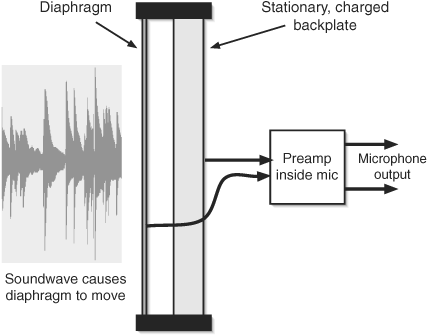
Figure B.1. The output signal in a condenser microphone results from the motion of the diaphragm in relation to the backplate.
backup. 1. A copy of important data made in case of computer or drive failure. ![]() See also back up. 2. A spare piece of equipment for use in the event of gear failure.
See also back up. 2. A spare piece of equipment for use in the event of gear failure.
back up. To make a copy of valuable data on a separate disk or other medium for safekeeping. ![]() See also backup.
See also backup.
backward-compatible. Data or media that will work with earlier versions of a system or piece of software.
backward masking. Audio content on a recording that can be perceived or understood only when the recording is played in reverse. The idea is for the backward-masked material to sound like part of the music when played forward, but for the message or other content to pop out and become audible when heard in reverse.
baffle. 1. The panel or surface of a speaker cabinet on which the driver is mounted. The baffle is designed to separate the sound coming from the front of the speaker from the sound coming from the rear to prevent interference and phase cancellation. 2. An acoustic divider, usually absorptive, placed to increase the isolation between two sound sources during recording. ![]() See also gobo.
See also gobo.
baffled stereo. A stereo miking technique in which a baffle is placed between the two microphones to enhance the separation between the left and right channels. ![]() See Jecklin Disc for one example.
See Jecklin Disc for one example.
balance. 1. A control that adjusts the relative volume level of the two tracks that make up a stereo signal. 2. MIDI Continuous Controller #8, which is defined as control over stereo balance.
balanced. The opposite of unbalanced. A balanced connection uses three conductors—positive, negative (which carries a polarity-inverted version of the positive signal), and ground—within one cable to carry a signal. When the balanced signal arrives at its destination, the positive and negative signals are inverted to be in phase and then are added together to cancel any common noise picked up by both the positive and negative conductors in the cable (known as common mode rejection). For this reason, balanced cables are quieter than unbalanced connections and can be run for longer distances. (See Figure B.2.) Balancing is also used with AC power lines to ensure clean power.
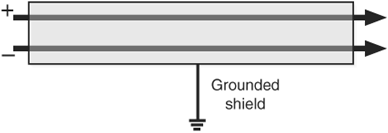
Figure B.2. A balanced audio signal has positive and negative signals that are added together, canceling any noise picked up by the cable. A grounded shield surrounding the two conductors also helps to protect against noise and interference.
balanced power. A type of 120-volt AC power circuit that is created using a transformer and functions in similar fashion to a balanced audio signal. There are positive and negative conductors carrying 60 volts each, as well as a ground conductor. When the electricity reaches its destination, any connected equipment sees a total 120-volt difference between the positive and negative conductors. As the voltage between the positive and negative conductors adds, any noise in the lines is cancelled, resulting in “clean” power and reduced line noise. ![]() See also balanced.
See also balanced.
banana plug. A type of audio connector commonly used for speaker-level signals. Banana plugs can be single or dual. In the dual version, the two plugs are spaced 3/4 inch apart to ensure compatibility with the binding posts found on many power amplifiers and speaker cabinets. (See Figure B.3.) Banana plugs are often designed to “stack” together, making it easy to daisy-chain speaker cabinets together. ![]() See also binding post.
See also binding post.
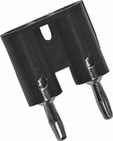
Figure B.3. A dual banana plug is compatible with the binding-post connectors found on many power amplifiers and speaker cabinets.
band. 1. An assemblage of musicians. 2. A range of frequencies.
band limit. The use of a filter to restrict the range of frequencies that is allowed to pass through a system.
band reject filter. A filter that attenuates or restricts the passage of a certain range or band of frequencies, while allowing the frequencies that are outside that range to pass unimpeded. (See Figure B.4.) The opposite of a bandpass filter.

Figure B.4. A band reject filter attenuates a central band of frequency, while allowing frequencies above and below the band to pass unaffected.
bandpass filter. A filter that allows a certain range or band of frequencies to pass, while attenuating or rejecting frequencies that are outside that range. (See Figure B.5.) The opposite of a band reject filter.
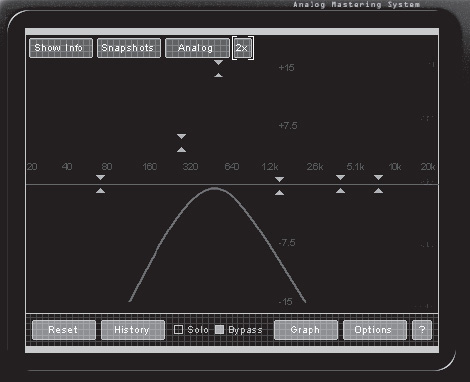
Figure B.5. Bandpass filters allow only a certain range of frequencies to pass, while attenuating or rejecting all other frequencies.
bandwidth. 1. A range of frequencies. 2. The amount of space required or available to carry a signal.
bank. A group of presets or patches within the patch memory of a synthesizer or processor. Banks may be organized by number (Bank 1 contains presets 1 to 100, and Bank 2 contains presets 101 to 200), type (one bank contains presets for processing vocals, another for guitar, and another for drums), presets created at the manufacturer (Factory Bank) and those created by the user (User Bank), or some other scheme.
bank select. MIDI allows 128 presets to be called up when using MIDI program change messages. The problem is that many devices have more than 128 presets, and they are often organized into multiple banks. To allow access to more than 128 presets, the MMA (MIDI Manufacturers Association) specified “bank select,” MIDI controller messages (Continuous Controllers #0 and #32) that allow a bank of presets within a synthesizer or other piece of gear to be selected. An individual preset can then be called up from within the selected bank using a program change message. Depending on the piece of gear, either controller or both controllers may be required to call up the bank. Using both controllers, up to 16,384 banks can be accessed, each of which can hold up to 128 MIDI-accessible presets. This would allow access to a total of 2,097,512 presets via MIDI, which is more than enough for producing or performing most songs.
bantam. ![]() See tiny telephone.
See tiny telephone.
barrier miking. A microphone technique in which the mic is placed very close to a reflective surface to reduce interaction between direct and reflected sound, thereby preventing phase cancellation. ![]() See also boundary microphone.
See also boundary microphone.
barrier strip (a.k.a. terminal block or terminal strip). A type of connector that uses screw posts to affix the cables or wires instead of jacks and plugs. Found on certain pieces of audio equipment that are intended for permanent or semi-permanent installation.
bass. 1. Low frequencies or pitches. 2. An instrument with four, five, six, or even more strings that (usually) provides the low notes in a musical arrangement. 3. The lowest male voice section in a choir. 4. A type of fish.
bass management. A system used to route the low frequencies from a stereo or surround audio signal to feed a subwoofer. According to the Dolby specification, the crossover point for bass management is 80 Hz.
bass reflex (a.k.a. ported). A speaker cabinet design that uses a “port” or hole to enhance the bass response. The sound from the rear of the speaker driver inside the cabinet is routed out through the port so that it combines with the sound coming from the front of the speaker driver. This increases the low-frequency efficiency of the cabinet compared to a sealed or open-back cabinet. See Figure B.6.
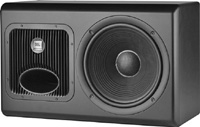
Figure B.6. The port in a bass reflex speaker cabinet increases low-frequency output by routing sound from the rear of the speaker out the front of the cabinet.
bass trap. An acoustic device designed to absorb low-frequency sound waves.
baud rate. A measure of the data transfer speed of a device such as a modem. Named for French telegrapher Emile Baudot. For current technologies, bits per second (bps) is a more accurate measurement than baud rate.
beaming. The tendency of high frequencies to project in a straight line. With speaker drivers, beaming generally begins to occur when the wavelength becomes smaller than the diameter of the speaker or throat of the driver. Horn-based designs help to improve sound dispersion and reduce beaming.
beat. 1. The primary time unit or pulse in music. 2. A drum pattern or loop.
beatboxing. The use of the human voice or body to create percussion sounds.
beating. Cyclical cancellations and reinforcements that can occur when two sound waves of nearly equal frequency (within 30 Hz or so of one another) are combined. Many guitar players tune by striking the same harmonics on adjacent strings and adjusting the pitch of one to match the other, at which point any beating stops. If complex sounds are combined, beating can occur between similar partials within the two sounds.
beat juggling. A DJ technique that is used to create a new piece of music by combining the drums from one record and a riff or vocal part from another record.
beat matching. A DJ technique used in dance clubs to create a smooth transition from the end of one song to the beginning of another without a break between them. Beat matching involves using the pitch control of a turntable or other means to ensure that the tempos of the two songs are the same and that the beats line up rhythmically.
beats per minute. ![]() See BPM.
See BPM.
Beige Book. One of a set of “Rainbow Books” with colored covers containing the Sony/Philips-developed specifications for different optical compact disc formats. The Beige Book contains the specification for Photo CD.
bel. A unit of measure expressing the amount a signal drops in level over one mile of telephone wire. Named for Alexander Graham Bell, the inventor of the telephone and researcher into sound, speech, and hearing.
bell filter (a.k.a. haystack filter). A filter that boosts or cuts a band of frequencies around a center frequency, resulting in a basic bell-curve shape to the boost or cut response. See Figure B.7.

Figure B.7. Bell filters have a response curve that resembles the basic bell curve when boosting or cutting.
beta. A final pre-production version of a product released to a limited number of users for real-world testing in order to determine the stability and quality of the product before it is offered to the general public.
Bezier curve. A mathematically generated curve that requires three or more points—two “anchor” or start and end points, and other points, called splines, that determine the shape of the curve. (See Figure B.8.) The more splines in the curve, the more complex the curve can be. Some audio programs provide Bezier curve functions for drawing and reshaping automation data for volume, pan, and other parameters. Named for French mathematician Pierre Bezier. ![]() See also breakpoint automation.
See also breakpoint automation.
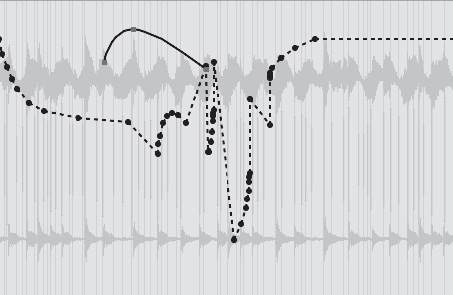
Figure B.8. Bezier curves are mathematically generated and shaped based on splines, or data points. In this example, the handle, or spline, can be used to shape the curve.
bi-amp. Using a crossover to split a signal into two frequency ranges (high and low) and sending those ranges to separate amplifiers and speakers optimized for those ranges.
bias. 1. A 100-kHz or higher signal applied to magnetic tape during recording to reduce distortion and increase linearity. 2. A small voltage applied to a tube’s grid to reduce distortion and increase linearity. 3. A small voltage applied to an FET’s gate to reduce distortion and increase linearity. 4. A small current applied to a bipolar transistor’s base to reduce distortion and increase linearity. For all four, bias must be set properly, or distortion will increase and/or level and high frequencies will be reduced. 5. The tendency for a musician to always want his or her own part to be the loudest in a mix.
bias beat. A tone or artifact that results when the bias frequencies on two synchronized analog recorders are slightly off.
bi-directional/bidirectional. 1. Carrying signal in two directions. 2. A microphone polar pattern. ![]() See also Figure 8.
See also Figure 8.
binary. 1. Composed of two parts or things. 2. A number system that uses two as its base, rather than 10, as in our standard system. The binary numbering system uses two values, 0 and 1. This system is the standard for electronic devices, as these two values are easy to represent by high or low voltages or as bit values. As you move to the left in a binary number, each digit doubles in value. See Table B.1.
Table B.1. Examples of Binary Numbering
Base 10 | Binary |
|---|---|
0 | 0000 |
1 | 0001 |
2 | 0010 |
3 | 0011 |
4 | 0100 |
5 | 0101 |
6 | 0110 |
7 | 0111 |
8 | 1000 |
9 | 1001 |
10 | 1010 |
11 | 1011 |
12 | 1100 |
13 | 1101 |
14 | 1110 |
15 | 1111 |
binaural. A recording technique that attempts to duplicate how human hearing responds in terms of phase, directionality, and physical separation. This is generally accomplished using two microphones mounted in either a dummy head or a sphere, which keeps the sound entering each mic separate, simulating how our ears work on the sides of our heads. The binaural effect is generally best heard through headphones.
binding post. A type of connector often found on power amplifiers and speaker cabinets. Binding posts can accept banana plugs, bare wire, alligator clips, and other cable terminations. This type of connector is convenient and fast, and it offers good connectivity for carrying speaker-level signals. ![]() See also banana plug.
See also banana plug.
BinHex. Short for Binary-to-Hexadecimal. A method for converting eight-bit binary files into seven-bit ASCII files so they can be sent through email as text. BinHex files usually have the .hqx extension.
BIOS. Basic Input/Output System. Software that controls how a PC interfaces with its keyboard, mouse, monitor, hard drives, and other hardware, as well as instructions for booting up and other useful utilities.
Bit. Contraction of binary digit. Each bit can have only two possible values, zero or one. ![]() See also binary, bit resolution.
See also binary, bit resolution.
bit depth. ![]() See bit resolution.
See bit resolution.
bit mapping. A scheme somewhat similar to dither and noise shaping for optimizing audio quality when reducing digital word length. Sony’s Super Bit Mapping is a common example, which claims the sound quality of 20- or 24-bit resolution using 16 bits. ![]() See also dither, noise shaping.
See also dither, noise shaping.
bit rate. ![]() See bps.
See bps.
bit resolution. The number of bits available to represent an audio signal in the digital domain. Each bit of resolution provides roughly six decibels of dynamic range. Though it may seem counterintuitive, increased bit resolution improves the ability of a digital device to represent low-level signals (not high-level signals). As the audio level is decreased, the number of bits available to describe the audio signal decreases, thus reducing the integrity of the signal and introducing distortion. With higher bit resolutions, there are more bits available to represent these low-level signals. See Figure B.9 and Table B.2.
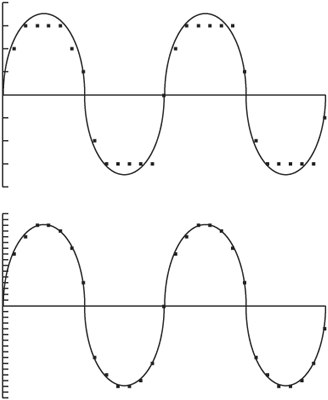
Figure B.9. Adding more bits to a digital audio system increases the resolution from low (top) to high (bottom), resulting in a more accurate picture of the audio waveform.
Table B.2. Increasing the Number of Bits Also Increases the Available Resolution and Dynamic Range
Bit Depth | Resolution | Dynamic Range |
|---|---|---|
1 bit | 2 steps | 6 dB |
2 bits | 4 steps | 12 dB |
3 bits | 8 steps | 18 dB |
4 bits | 16 steps | 36 dB |
8 bits | 256 steps | 48 dB |
12 bits | 4,096 steps | 72 dB |
16 bits | 65,536 steps | 96 dB |
20 bits | 1,048,576 steps | 120 dB |
24 bits | 16,777,216 steps | 144 dB |
bit splitting. A method for recording high-resolution digital signals to a low-resolution recorder. For example, by splitting the digital words in a 24-bit/48-kHz signal, it can be recorded to two 16-bit/48-kHz tracks on an ADAT or other recorder, with 16 bits of data stored to one track and the remaining eight bits stored to the subsequent track. Typically, whatever device does the bit splitting will also perform the reverse operation, rebuilding the 24-bit/signal from the two low-resolution tracks.
blackburst (a.k.a. video sync or house sync). A video signal with no color information, only black. Since the black-only signal contains video frame information, a blackburst generator can be used as a master clock to synchronize video equipment for editing or other purposes.
bleed (a.k.a. spill). Sound waves “leaking” from one space to another or into a microphone not intended for the sound source that creates them.
BLER. Short for Block Error Rate. Data is written in a series 512- or 1,024-byte blocks on CD and hard drives. The BLER is a measure of how many blocks have errors or can’t be read. Too many error blocks will make a disk difficult or impossible to read.
block. A 512- or 1,024-byte (or other size) chunk of data on a compact disc or hard drive. Smaller blocks allow for less wasted space on the disk; three 512-byte blocks would be required to store a 1,100-byte piece of information. (The unused space in the third block cannot be used for storing other information.) The same 1,100-byte piece of information would require two 1,024-byte blocks, but more space would go unused in the second block. See Figure B.10.
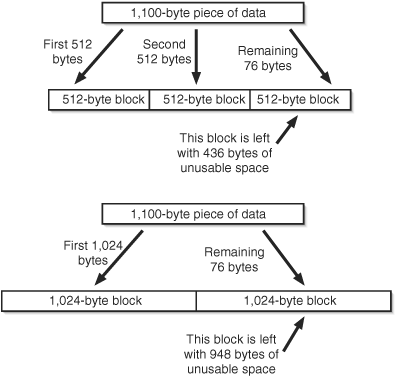
Figure B.10. A comparison of how data block size can impact how much data can be stored on a disc or drive—the larger the block size, the more space is wasted.
Blue Book (a.k.a. CD-Extra). A CD format specification jointly developed by Sony and Philips. The Blue Book spec is in the Mixed Mode family and supports placing both audio and data on the same optical disc. Different variations include CD-Plus, Enhanced CD, CD+G, and more. The Blue Book standard fixed a problem with some older CD players that sometimes had difficulty playing Mixed Mode discs, as the data portion on Audio Track 1 would be played as a loud burst of noise.
Bluetooth. A wireless technology that operates in the 2.4-GHz range and is intended as a low-power, low-cost solution for interconnecting computers, PDAs, cell phones, printers, keyboards, mice, and other equipment. The first version of Bluetooth was intended for short-range use, with a range of 10 meters. But later power classes upped the maximum range to 100 meters.
Blumlein pair. A stereo miking technique developed by EMI chief engineer Alan Blumlein during the 1930s. Two coincident bidirectional (figure-8) microphones are angled at 90 degrees to one another. In addition to a strong center image, a great deal of ambience will be captured. For this reason, a good-sounding room is required for best results with Blumlein pairs. See Figure B.11.

Figure B.11. In a Blumlein pair, two figure-8 microphones are placed at 90 degrees to one another in front of a sound source. The result is a strong center image and good pickup of room ambience.
BMI. Broadcast Music, Inc. A nonprofit organization that licenses copyrighted works and collects and distributes royalties for songwriters, composers, and music publishers. www.bmi.com.
BNC (a.k.a. bayonet connector). A coaxial connector found on test equipment and used to carry digital clock synchronization information for audio gear. Named for its inventors, Paul Neill and Carl Concelman, and its “bayonet” connection type, which uses two small pins to latch the plug to the jack.
boost. To increase. In audio, this usually refers to amplitude or gain.
Boot Camp. Apple software that allows an Intel-based Macintosh to run the Windows XP and Vista operating systems.
booth. ![]() See isolation booth.
See isolation booth.
bounce. To combine tracks together to mono or stereo and re-record the result to a new mono or stereo track. The original tracks are then freed up to record more signals. Bouncing was common in the days of analog and digital tape machines, which had a limited number of tracks. It is less common today, when most computer-based DAWs offer unlimited tracks. ![]() See also bounce to disk.
See also bounce to disk.
bounce to disk. A process found in many DAWs that records the mono, stereo, or surround output of the mixer to the hard drive. This eliminates the step of having to record the final mix to an external machine or back into new tracks. All edits and plug-ins, fades, and other processing are included in the bounce. Some systems bounce in real time—the same amount of time it would take to play back the project. Other systems can bounce faster than real time—in less time than it would take to play back the project.
boundary microphone. A microphone designed to be placed against or near a reflective surface to reduce the interference between direct and reflected sound. Sound waves in close proximity to a surface—called the pressure field or pressure zone—are in phase with those reflecting from the surface, resulting in a 6-dB increase in level. The benefits are increased microphone sensitivity and tonal consistency regardless of the distance of the source from the mic. Boundary microphones are often placed on boardroom conference tables and on the stage floor at theaters to pick up sound at plays and musicals, and they are employed in studios to record pianos, drums, and other sound sources. Boundary mics are sometimes referred to as pressure-zone microphones or PZMs, though this is a trademarked term.
BPM. Beats Per Minute. An indication of the tempo of a piece of music.
bps. Bits Per Second. A measurement of digital data flow. Sometimes mistakenly called baud rate. ![]() See also Kbps, Mbps.
See also Kbps, Mbps.
Bps. Bytes Per Second. A measurement of digital data flow. ![]() See also KBps, MBps.
See also KBps, MBps.
braided shield. A type of cable shielding created by braiding wire strands (usually copper) around insulated conductors. ![]() See also shield.
See also shield.
breaker. ![]() See circuit breaker.
See circuit breaker.
breakout box. A box that provides individual access to multiple channels or signals carried over a single multi-wire cable. The most common example is the stage box end of an audio snake used in live sound applications. See Figure B.12.
breakpoint automation. A type of automation system that uses data points inserted into a track to define the automation “curve” (see Figure B.13). By adding, deleting, or moving the breakpoints, the shape of the curve can be changed. Breakpoint curves are based on straight lines, rather than curves as in Bezier curves. ![]() See also Bezier curve.
See also Bezier curve.

Figure B.13. Linear automation “curves” are created using data points (called breakpoints) inserted in a track.
breath controller. 1. A hardware device that connects to a keyboard or sound module and senses airflow. The player blows in the breath controller, and the air velocity is measured. The resulting data is used as control data. Breath controllers are commonly used by keyboard players to add expression to performances. 2. MIDI Continuous Controller #2, which is defined to carry breath controller information.
breathing. The audible rise and fall of the noise floor between sounds in a compressed signal. Breathing results from a large amount of compression being applied, which allows the average level to be increased, simultaneously raising the level of noise in the “silences” between sounds. Adjusting the compressor’s release time can help reduce breathing. ![]() See also pumping.
See also pumping.
brickwall filter. A filter with an extremely steep cutoff slope. Brickwall filters are useful for applications such as anti-aliasing filters, but they often have unacceptable audible side effects when used in other applications.
brickwall limiter. A limiter with an extremely high ratio (such as infinity:1) that prevents audio levels from exceeding a certain threshold. Most commonly used to prevent overs in digital systems and for overload protection in amplifiers and sound systems.
bridged (a.k.a. mono bridged). A power mode found on some amplifiers that allows two channels of an amp to drive a single speaker for increased power output. The same signal is sent to the inputs of two amplifier channels, with one channel flipped to reverse polarity. When the speaker is connected across the positive terminals of the amp’s channel outputs, it sees much higher power than it would from one of the channels alone. It is important to ensure that the speaker being used has the correct impedance when bridging an amplifier (usually twice the minimum impedance for the amp). Check your amp’s manual first!
British EQ. An equalizer circuit or algorithm that attempts to re-create characteristics of the EQ found in certain UK-built mixing consoles, such as Neves and Tridents (among others), that were in production in the 1950s, ’60s, and ’70s.
broadband. 1. Effective over a wide range of frequencies. 2. A high-speed transmission method.
broadband absorber. Acoustic device designed to absorb sound waves across a wide range of frequencies.
broadband noise. Noise that comprises a wide range of frequencies.
Broadcast WAV file (a.k.a. BWF). An extension of the common Microsoft WAV file format. Broadcast WAV files include metadata that allows for easy transfer of audio files between different software programs and computer platforms. Among the most useful information in the Broadcast WAV file is time stamping, which specifies where the file is located in a track. Time stamping allows the file to be quickly and easily realigned when it is imported into another program or session.
BTD. ![]() See bounce to disk.
See bounce to disk.
buffer. 1. A small amount of temporary memory that’s used to manage and even out real-time transfer of data from, to, or within a computer. The size of the buffer is important to the success of many tasks, such as CD burning, audio recording and playback, and more. 2. A type of amplifier or preamplifier that interfaces pieces of equipment together.
buffer size. The amount of RAM contained in a buffer.
buffer under-run. A situation that can arise during data transfers where there is not enough data in a buffer to feed the receiving device. Buffer under-runs were common problems in the early days of CD burning, but are less common today.
bug. Computer jargon that refers to a problem in the software code that causes an error.
bulk dump. A method of transferring a large quantity of data (for example, the patch memory of a synthesizer) out of a device using MIDI system exclusive messages. Useful for transferring information into a computer for editing or backup/archival purposes.
bulk load. Transferring data into a device using MIDI system exclusive messages. ![]() See also bulk dump.
See also bulk dump.
burn. To write or create a CD-R/RW or DVD-R/RW.
burn in. 1. Powering or operating a piece of gear to uncover infant failure. 2. Operating a piece of equipment, such as a speaker, for a period of time to break it in. 3. An image permanently etched on a video screen after it has been displayed for a long period.
burst. 1. A short blast of audio used for calibrating equipment. A burst can be either a tone burst, which contains sine waves, or a noise burst, which contains white or pink noise. 2. A video signal that contains no information. ![]() See also blackburst.
See also blackburst.
burst transfer rate (a.k.a. maximum transfer rate). The maximum data transfer rate a drive can attain. Sustained transfer rate is a better measure of drive performance with audio and video applications.
bus. A circuit or virtual signal path that collects audio signals and routes them to a specific destination. Examples include a mix bus, aux bus or send, or effects bus.
bus bar. A common feature of mixing consoles, in which a metal rod is used to bring together all the grounds in the unit and route them to a single earth location.
buss. A kiss. ![]() See bus.
See bus.
butt splice. 1. With analog tape, joining together two pieces of tape that are cut at 90-degree angles. Because a butt splice may pop or click when it crosses the playback head, angled splices are preferred by many engineers. 2. Two regions of digital audio in a track that are joined together to play continuously. A crossfade may be required for smooth playback.
BWF. ![]() See Broadcast WAV file.
See Broadcast WAV file.
bypass. A setting that routes a signal through a device without being processed or effected. In hardware, there are two types: regular bypass, which generally includes a buffer amp in the signal path, even when the device is bypassed, and “true” bypass, in which the input of the device is connected directly to the output.
Byte. An 8-bit binary “word” or grouping of data. ![]() See also KB and MB.
See also KB and MB.

